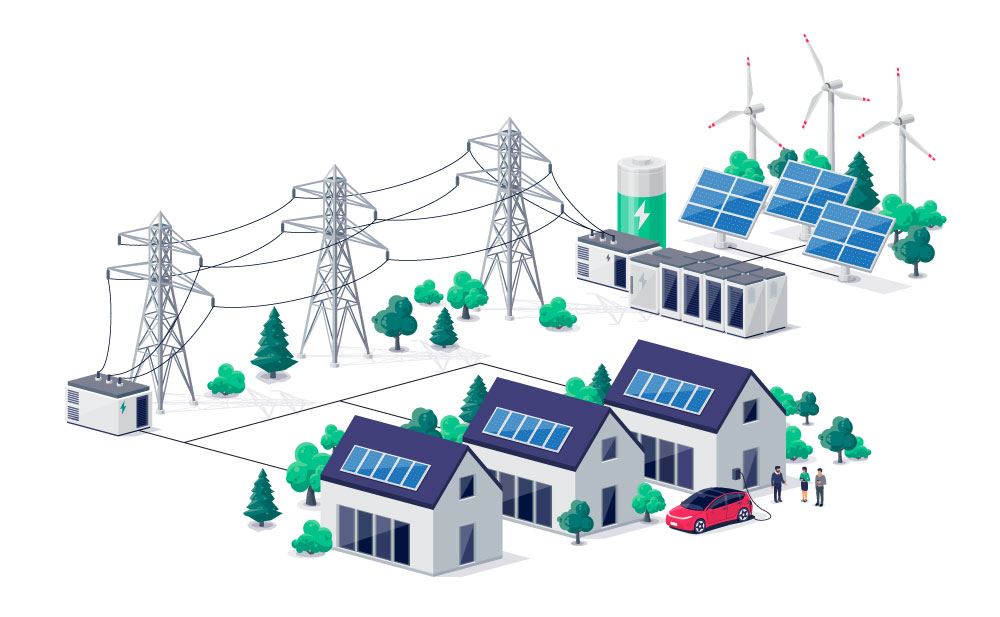FINE – Flexible Integration of Local Energy Communities
What is the impact of introducing Local Energy Communities?
Contact person

A new approach to energy management
Local Energy Communities, where residents and businesses collaborate on energy generation, storage, and sharing within a defined geographical area, represent a novel approach to energy management. By introducing such communities, the energy system has the potential to become more flexible and sustainable while also making better use of local resources. The FINE project has conducted analyses to understand both the opportunities and challenges of integrating energy communities into the distribution grid. These analyses are based on scenarios developed earlier in the project, which provide a foundation for understanding different development paths and their implications.
Key findings from the analysis
The research within the FINE project highlights both the advantages and challenges of introducing energy communities. Using modeling and scenario-based analysis, several key insights have been identified on how energy communities can influence the power grid and the energy system.
Energy communities have the potential to reduce peak loads in the power grid. By balancing local energy generation, storage, and consumption, the strain on the grid can be alleviated, and energy generated by renewable sources, such as solar panels, can be better utilized. In scenarios where both energy communities and distribution system operators actively collaborate, peak loads can be significantly reduced. This offers economic benefits by postponing grid expansion and improves resource optimization.
The research also shows that energy communities can enhance access to flexibility in the power grid. This flexibility, which includes local storage and adjustments in consumption patterns, can be offered as services to the grid. Such flexibility makes it possible to address challenges related to increased electrification and variable production from renewable sources like solar and wind power. However, this flexibility must be well-coordinated with distribution system operators to avoid new peak loads or inefficient energy flows.
One crucial finding is how economic incentives can motivate energy communities to actively participate in markets. In scenarios involving market platforms, energy communities can offer flexibility services to distribution system operators, creating economic value for both parties. However, this requires the development of regulatory frameworks that support such transactions while ensuring fairness and equal opportunities for all stakeholders.
Challenges of integration
Despite the significant potential, the research also highlights several challenges associated with integrating energy communities. Increased decentralization introduces a more complex management structure for the power grid, requiring advanced technological solutions. Smart meters, real-time data, and automated systems are necessary to ensure efficient operations.
Additionally, the research points to regulatory gaps that need to be addressed to realize the potential of energy communities. Current regulations are often tailored to centralized energy systems, and reforms could be needed to provide energy communities with proper access to flexibility markets. Tariff structures must also be designed to create opportunities for energy communities while ensuring that other grid users are not burdened.
Differentiation between scenarios
The research shows that different integration scenarios lead to varying outcomes for the power grid. In the reference scenario, current practices are continued, with energy communities playing a minimal role and grid challenges addressed mainly through grid reinforcement. In the competitive scenario, distribution system operators leverage market platforms to purchase flexibility from energy communities. While this enables more flexibility in the system, it also imposes high demands on technology and regulations.
In the cooperative scenario, energy communities take responsibility for balancing local generation and consumption, with minimal involvement from distribution system operators, who only need to set boundary conditions for grid usage. While effective, this approach requires robust local management mechanisms and high participation rates in the energy community area. The participatory scenario, which combines local collaboration with market integration for flexibility, offers the greatest potential but also entails the highest complexity. Here, energy communities and distribution system operators share responsibility for flexibility and balance, delivering economic and operational benefits to both parties.
Practical implications
The analyses conducted in the FINE project demonstrate how energy communities can become a vital part of the future energy system. With proper implementation, they can reduce costs associated with grid expansion, promote the use of renewable energy sources, and increase community engagement in the energy transition. However, success depends on the development of sound regulatory frameworks, advanced technology, and effective collaboration between stakeholders at all levels.
Read more
For more information on the analyses and scenarios, see:
- FINE final report
- Article with analysis of the scenarios: Askeland, Magnus and Bjarghov, Sigurd and Rana, Rubi and Morch, Andrei and Taxt, Henning, Smart Flexibility in Energy Communities: Scenario-Based Analysis of Distribution Grid Implications and Economic Impacts. Available at SSRN: https://ssrn.com/abstract=5061422 or http://dx.doi.org/10.2139/ssrn.5061422
